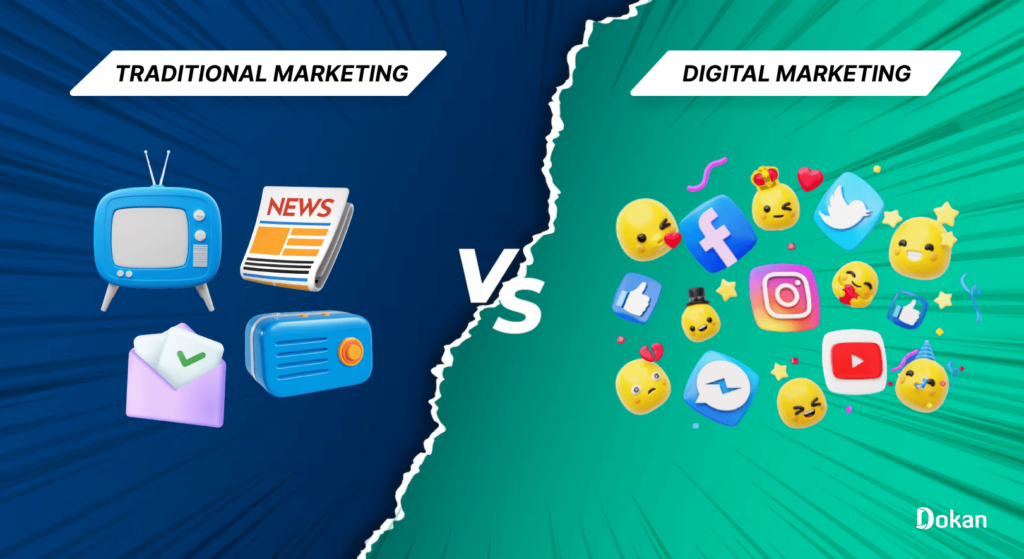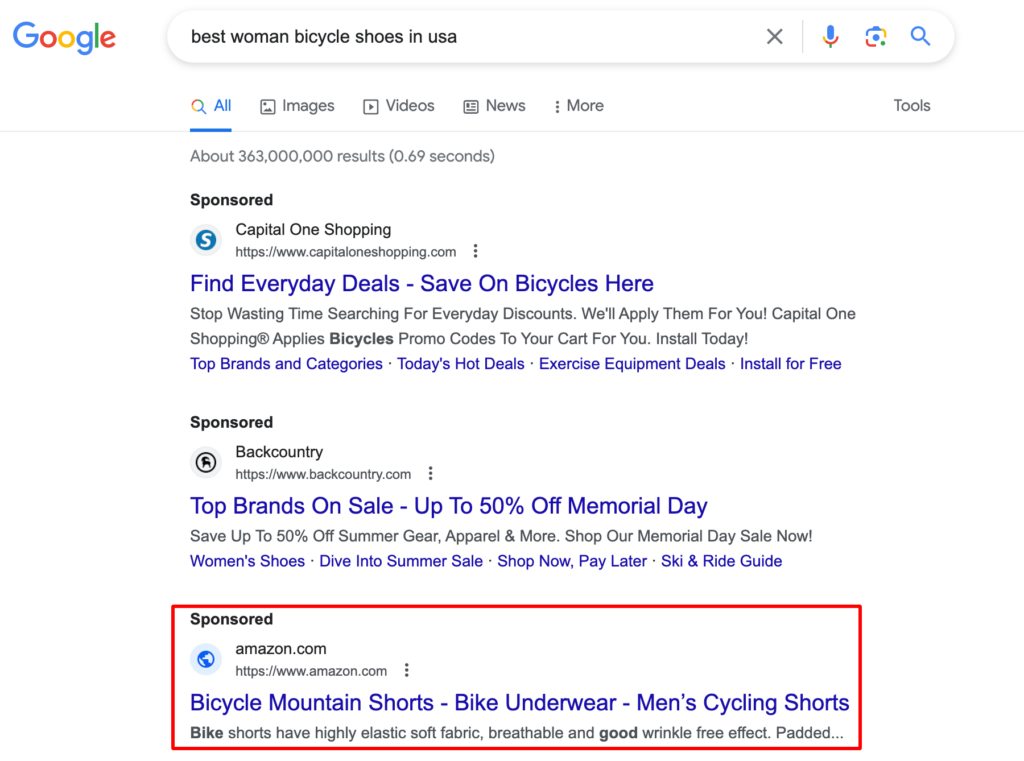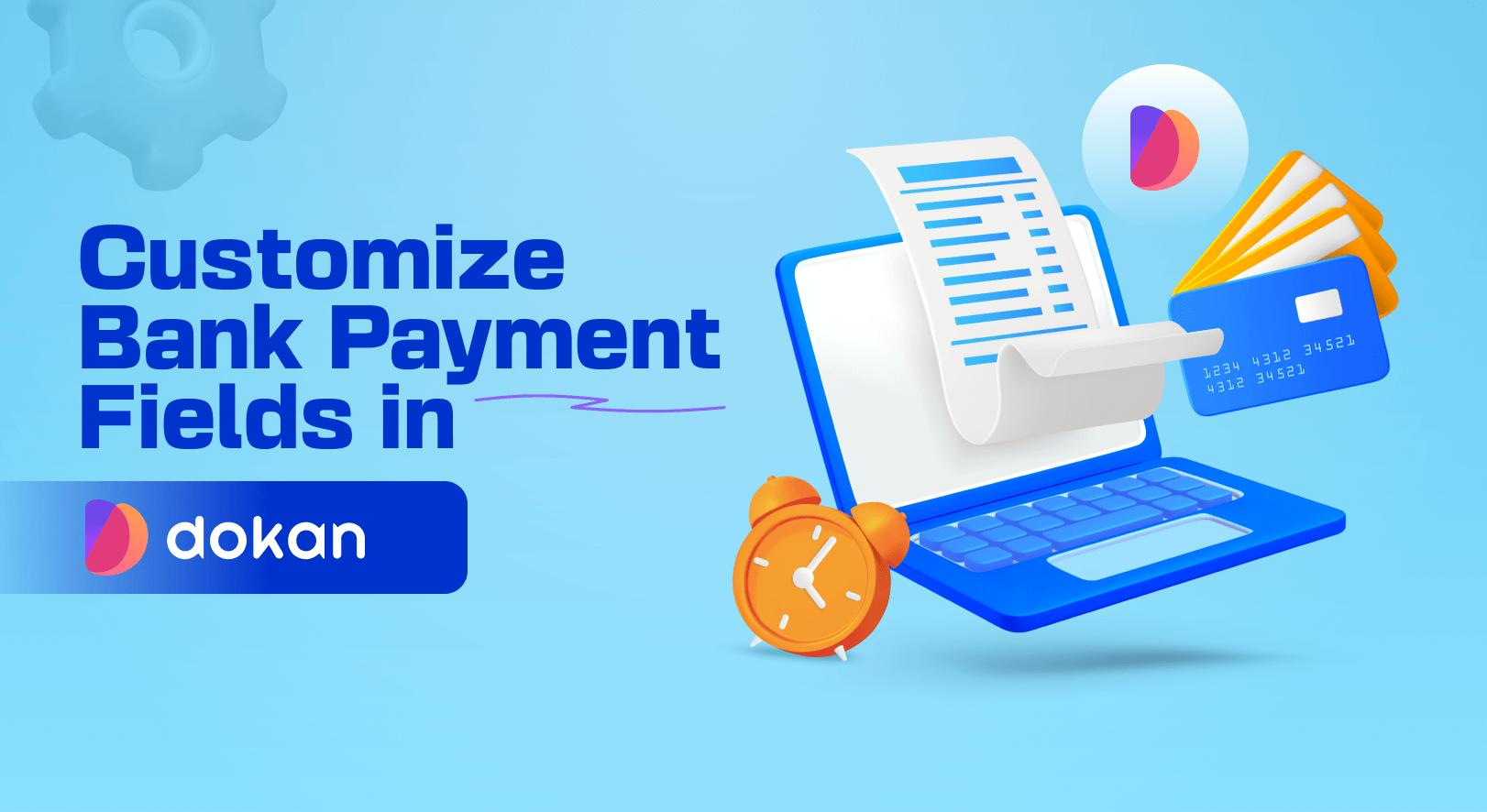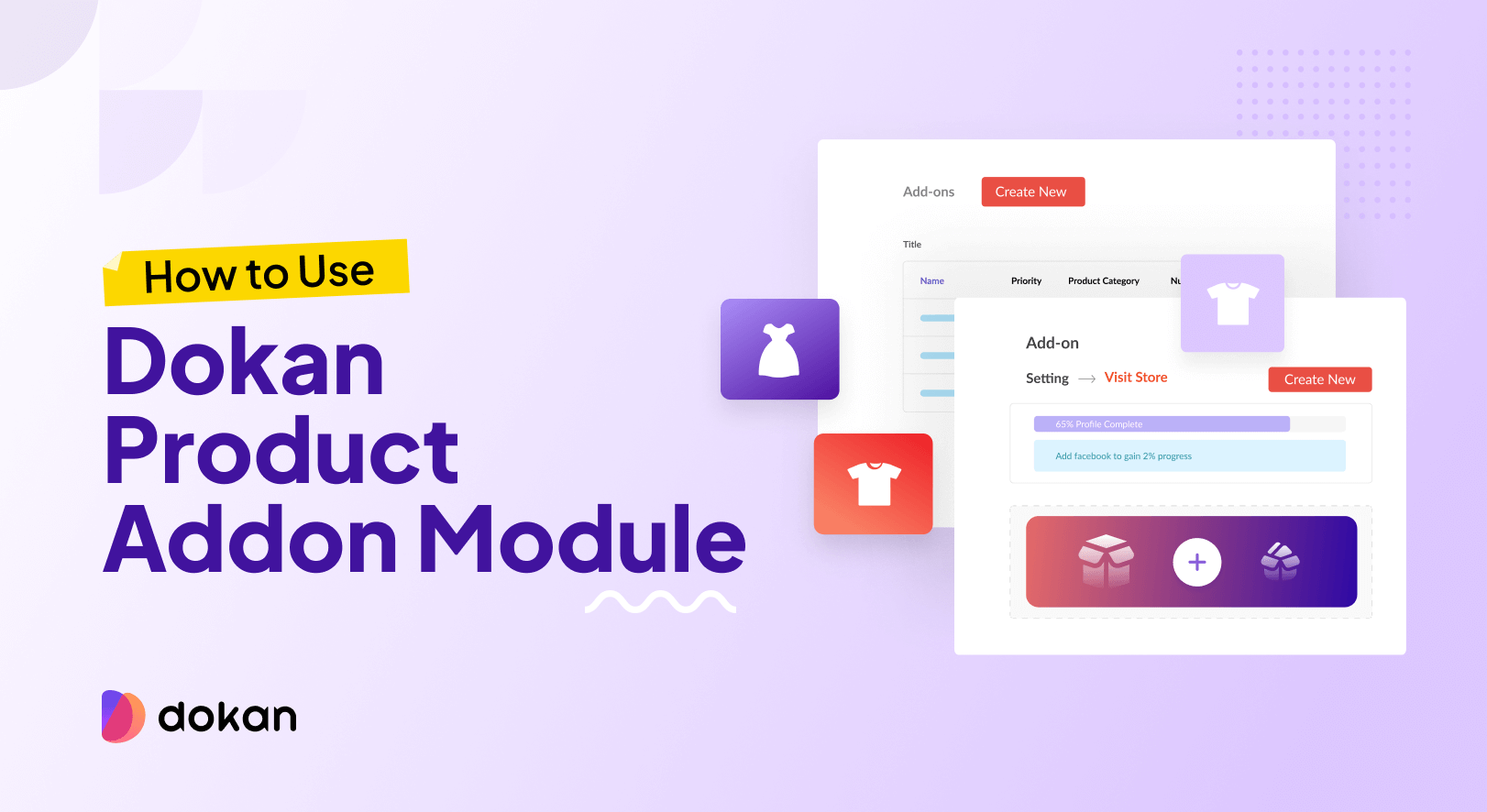eCommerce has turned marketing into a 24/7 game. From the age of door-to-door sales to the era of eCommerce, the marketing game has evolved beyond imagination. Check the revolutionary history of how eCommerce has transformed marketing, so you can pick the right strategies for your online store.
People’s shopping behavior has undergone significant changes over the years, primarily due to technological advancements. Now, they are more comfortable with online shopping rather than waiting in long queues at physical stores.
In 2022, there were 268 million digital buyers in the United States. This number is estimated to reach almost 285 million in 2025.
Statista
However, the increasing popularity of eCommerce hasn’t just changed people’s shopping habits. It has also transformed the way of overall retail marketing approaches.
In this blog, we’ll walk you through the 7 most efficient ways eCommerce transformed marketing. So you can better understand the changing landscape of marketing and its impact on future business models.
The Evolution of Marketing – Traditional to Digital

Over the past few decades, marketing has undergone a significant transformation from traditional to digital.
The traditional marketing approach primarily focused on-
- Print media
- Television commercials
- Billboards
- Radio ads, etc
These methods were effective in their time. However, with the advent of new technologies, digital marketing has become more popular.
Digital marketing refers to the use of digital channels to promote products and services. This includes
- Email marketing
- Social media marketing
- Search engine optimization, and more.
Digital marketing allows businesses to target specific audiences and personalize their marketing efforts for maximum effectiveness.
Read More: Exploring How eCommerce Has Changed Our Business Forever.
Amplification of Digital Marketing Due to eCommerce Growth
As modern customers now prefer online shopping over going to physical stores, digital marketing has become essential for any type of business.
Digital marketing offers businesses an opportunity for more targeted advertising based on user demographics or interests. It results in higher conversion rates compared to traditional methods which are often less personalized.
Furthermore, digital channels offer greater flexibility when it comes to creating campaigns. You can bring quick changes to your strategies based on performance metrics such as click-through rates (CTR) or return on investment (ROI). In contrast, traditional mediums are often static with limited room for modification once they have been created.
However, both forms of marketing have their advantages and disadvantages depending on business goals and target audience. But there is no denying that digital marketing has revolutionized how brands connect with consumers today.
Read More: Grow Your Audience By Adding Email Subscriptions to WordPress Blog.
How eCommerce has Transformed Marketing
From the beginning to now, the concept of marketing remains almost the same. Business owners or marketers always search for effective ways to reach their target audience within a limited budget and get the highest ROI.
When Newspapers or Television were the main way of entertainment, marketers used these mediums to promote their brands. But with technological advancement, people are more likely to spend their time on laptops or mobile phones. Moreover, social media also become a new form of entertainment.
According to Statistics 1.66 billion people are actually shopping online annually, while 78% of internet users are specifically researching products online prior to purchase.
This changing behavior of mankind makes digital marketing a new way of increasing brand awareness and creating a unique brand identity.
Digital marketing has not necessarily replaced traditional marketing forms entirely. However, it has significantly impacted and transformed certain aspects of traditional marketing. Here are a few examples:
- Search Engine Optimization (SEO) Brings Organic Traffic from Search Engines
- Social Media Marketing Allows Businesses to Engage with Their Customers
- Email Marketing Helps Businesses to Nurture Customer Relationships
- Content Marketing Helps Businesses Attract & Educate Their Target Audience
- Paid Search Advertising Drives Relevant Traffic to The Website
- Affiliate Marketing Provides a Cost-effective Way to Reach a Wider Audience
Let’s dive into the details-
1. Search Engine Optimization (SEO) Brings Organic Traffic from Search Engines
Search engine optimization (SEO) has become essential in the digital marketing landscape. SEO is the process of improving the ranking of a website in search engine results pages (SERPs).
And high ranking in search engines helps you capture more organic traffic.
By optimizing your websites for relevant keywords, it would be easier to attract more visitors from search engines, which can lead to more sales.
This modern-day approach reduced the use of traditional print advertising, such as classified ads in newspapers and directories. Instead of relying solely on print media, businesses now invest in optimizing their online presence.
2. Social Media Marketing Allows Businesses to Engage with Their Customers
Social media marketing is a powerful tool to connect with your target audience and build brand awareness. It offers a more targeted and interactive approach compared to traditional forms of advertising, such as TV commercials and print ads.
Rather than broadcasting messages to a broad audience, utilize social media platforms to reach a specified group of people. It helps you to find out what people are thinking about your business, products, or services.
You can use popular social media platforms like Facebook or Twitter for advertising, promotional giveaways, collecting customer feedback, and building customer loyalty.
3. Email Marketing Helps Businesses to Nurture Customer Relationships

Previously, businesses communicated with their customers through direct mail marketing. The new technique of email marketing automated the whole system.
Email marketing is the process of sending promotional emails to a list of subscribers. By sending targeted emails with relevant content, businesses can keep their subscribers engaged and drive sales.
Email marketing is one of the most cost-effective ways to reach a customer with personalization. It allows for automated email campaigns, segmentation based on customer behavior, and tracking of email engagement metrics.
Subscribe to
Dokan blog
4. Content Marketing Helps Businesses Attract & Educate Their Target Audience
As businesses shift from traditional marketing to digital marketing, there are changes in the way brands communicate with their audiences.
Public relations used to be the go-to strategy for building brand awareness and reputation. However, content marketing is quickly replacing it as a more effective method of reaching target markets.
According to recent research by the Content Marketing Institute, 91% of B2B marketers use content marketing to reach customers and prospects.
Content marketing is the process of creating and distributing valuable content to attract and retain customers. By creating high-quality content that solves problems for customers, you can build trust and credibility, which can lead to more sales.
5. Paid Search Advertising Drives Relevant Traffic to The Website
Paid search allows you to specifically target customers who are already searching for items similar to your products or services.
By bidding on relevant keywords, you can ensure that your ads appear at the top of the SERPs. It boosts the chance to get more clicks and more sales.
Additionally, paid search offers more flexibility and control over ad placement compared to print classifieds. This is the reason, many businesses have shifted their advertising budgets away from print classifieds towards paid search advertising campaigns.
6. Affiliate Marketing Provides a Cost-effective Way to Reach a Wider Audience
Affiliate marketing allows you to do partnerships with individuals or other companies. They will promote your brand in exchange for a commission on any resulting sales.
According to a study by Forrester Consulting, affiliate marketing drives 16% of eCommerce sales in the United States and Canada.
Affiliate marketing is replacing traditional sales promotions, such as coupon codes and discounts. Because it can be more effective to reach new customers and generate long-term revenue.
7. Influencer Marketing Expands The Opportunities to Reach Niche Market
Influencer marketing is the process of partnering with social media influencers to promote your products or services. Instead of signing big celebrities, startups are more likely to collaborate with local brand promoters to reach more specified potential customers.
It would be beneficial to collaborate with influencers who have significant online followers in a particular niche related to yours.
As you can see, digital marketing has transformed many aspects of traditional marketing. But traditional marketing is still useful for some businesses depending on the target audience, industry, and specific marketing goals.
An effective marketing strategy often combines both traditional and digital marketing techniques to leverage their respective strengths and reach a wider range of customers.
10 Significant Benefits of eCommerce to Promote Your Business
Marketers always aim to reach their target audience through the channels where prospects are most likely to gather and engage. This concept is the same for any type of marketing (traditional or digital).
As we know, eCommerce has changed human behavior in the last few years. People are now spending more time online. This is the reason, marketers are increasingly shifting their focus to online promotions.
More importantly, eCommerce offers numerous advantages that have transformed the marketing landscape.
Here are 10 advantages of eCommerce in marketing:
- Specific Customer Segmentation
- Wider Customer Accessibility
- Lower Cost and Efficiency
- Interactivity and Engagement
- Data-driven Insights
- Personalization
- Easy Scalability
- Wider Product Range
- Great Customer Service
- Social Media Integration
1. More Specific Customer Segmentation
eCommerce platforms provide valuable data and analytics about customers’ history, preferences, demographics, and purchase patterns. You can use this data to categorize your customers and create targeted marketing campaigns. It is also helpful to optimize your marketing efforts and deliver personalized messages.
2. Wider Your Customer Reach & Accessibility
Unlike physical stores with limited operating hours, eCommerce websites are accessible 24/7. Customers can make purchases at any time from your online store. Moreover, it enables you to reach a global audience without the limitations of physical boundaries.
3. Lower Cost and Efficiency
eCommerce eliminates many costs associated with brick-and-mortar stores. You don’t need to invest in a physical storefront, pay high rents, or hire a lot of employees. Moreover, you can promote your online store using digital marketing strategies which are comparatively more affordable than traditional marketing.
4. Interactivity and Engagement
eCommerce allows you to make a direct connection with your customers. Through different channels of online marketing, you can communicate with your target audience. You can use it to collect their problems, possible solution ideas, feedback, and others. Sharing emotions also helps to build a long-lasting relationship with your users.
5. Data-driven Insights
Digital marketing through eCommerce platforms gives you real-time data and analytics on campaign performance, customer engagement, conversion rates, and more. It helps you make data-driven decisions, optimize strategies, and measure the effectiveness of marketing efforts. Traditional marketing has limited options to track and measure campaign performance accurately.
6. Personalization
eCommerce ensures a personalized marketing experience. By analyzing customers’ data and purchase history, you can offer them customized product recommendations, tailored discounts, and specific messages or emails. It’ll enhance your customer engagement and loyalty.
7. Easy Scalability
With eCommerce, it’ll be easy to scale your business operations. You can easily add new products, expand your inventory, or cater to a larger customer base without significant investments.
8. Wider Product Range
eCommerce enables businesses to offer a wider range of products than traditional retail stores. Without physical space limitations, you can showcase and sell an extensive inventory. It provides your customers with more options to choose from.
9. Great Customer Service
eCommerce allows for efficient customer service and support. Nowadays most of the online stores have automated chatbots, FAQs section, and knowledge bases. It assists customers with general inquiries and provides instant support. Prompt and helpful customer service leads to higher customer satisfaction and repeat business.
10. Social Media Integration
eCommerce platforms seamlessly integrate with social media channels. It allows businesses to leverage social media marketing to drive traffic and increase sales. Also, you can run targeted ad campaigns and foster brand advocacy more effectively than traditional marketing methods.
There is no doubt, that eCommerce opens a lot of new doors for advanced marketing. It has become a powerful tool for businesses to connect with customers, drive sales, and stay competitive in the digital age.
However, it’s also important to note that traditional marketing still holds relevance in specific industries and target markets.

Who Are Still Using Traditional Marketing to Promote Their Businesses
Many businesses across various industries continue to use traditional marketing methods to promote their brands. Such as:
- Retail Stores
- Automobile Manufacturers
- Fast Food Chains
- Real Estate Agencies
- Insurance Providers
- Consumer Goods Manufacturers
- Financial Institutions
- Healthcare Providers
Besides using traditional marketing methods, these businesses also incorporate digital marketing strategies to complement their overall marketing efforts and reach a wider audience.
However, small to medium startups usually choose online marketing to save time and money as digital marketing is a cost-effective way to maximize your online presence and drive business growth.
Read More: 8 Actionable Tips to Protect Your WordPress eCommerce Website.
A Successful eCommerce Marketing Case Study
eCommerce has changed the way businesses market their products and services in several ways. These changes have made it possible for businesses to reach a wider audience, create more personalized marketing campaigns, save money, and offer more convenient shopping experiences. As a result, eCommerce has become a major force in the retail industry.
To see the impact of eCommerce marketing in action, let’s learn about the revolution story of Amazon.
Amazon is the largest eCommerce retailer in the world. Jeff Bezos started the company on July 05, 1994, in Washington, USA. Currently, Amazon has over 300 million customers worldwide and it has a brand value of $705.65 billion.
From fashion apparel to electronics, you’ll find almost any type of product on Amazon. Selling a wide range of products in diverse categories is not an easy task. Amazon uses a variety of techniques such as personalized recommendations, fast and reliable shipping, and excellent customer service to provide a seamless online shopping experience for customers.

Amazon plays regular ads on websites, newspapers, TV, billboards, and social media, along with other places. There are also plenty of affiliate sites that work with Amazon. As you can see, this giant eCommerce brand is utilizing both traditional and digital marketing strategies to boost its sales.
Read More: 11 Exclusive Features for Your eCommerce Store That Elevates Sales.
Bonus: Future Trends in eCommerce and its Impact on Marketing
The future of eCommerce is bright, and it is being driven by several trends, including:
- The rise of mobile commerce: Mobile commerce is growing rapidly, and it is expected to account for more than half of all eCommerce sales by 2023.
- The growth of social commerce: Many businesses start selling products and services directly from their social platforms. And this trend seems to rise in the upcoming days.
- The use of artificial intelligence (AI): Nowadays, AI is used to analyze customer data to create personalized shopping experiences.
- The growth of subscription commerce: This business model offers products and services regularly. The global subscription eCommerce market is forecasted to grow to US$2419.69 billion by 2028.
- The rise of live commerce: Live commerce is a new trend where businesses broadcast live videos of themselves selling products or services. This is a great way for businesses to connect with customers and build relationships.
These are just a few of the trends that are shaping the future of eCommerce. By understanding these trends, businesses can upgrade their strategies for the upcoming days.
Read More: Adding Essential Pages & Features to Your eCommerce Website.
Transforming Marketing Landscape: Integrating Traditional & Digital Approaches
Though people have been doing digital marketing for a long time, the evolution of eCommerce makes it more popular and convenient for users.
eCommerce has revolutionized the marketing landscape, transforming it from traditional to digital approaches. Businesses are now leveraging the power of eCommerce to reach wider audiences, personalize marketing efforts, track performance, and engage with customers.
However, it’s important to note that digital marketing and traditional marketing can be used together to create a more comprehensive marketing strategy. For example, you could use traditional marketing to raise awareness of your brand and then use digital marketing to drive traffic to your website or generate leads.
Are to planning to start a new online business or already running one? Check this eCommerce glossary and check 80+ terms related to online business.
No matter which type of marketing you choose, it’s important to track your results so you can see what’s working and what’s not. This will help you make necessary adjustments to your marketing strategy and improve your results over time.
Subscribe to
Dokan blog
We send weekly newsletters, no spam for sure!



